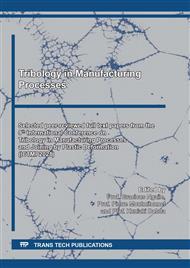[1]
G. Ngaile, Tube hydroforming chapter: Sheet metal forming, processes and applications (Ed. Altan. T. and Tekkaya E), ASME International, 2012, pp.179-209.
DOI: 10.31399/asm.tb.smfpa.t53500179
Google Scholar
[2]
J. Yang, B. Jeon, and S. Oh, 2001, Design Sensitivity Analysis and Optimization,, J. Mater. Process. Technol., 113(1–3), p.666–672. 061014-10 / Vol. 133.
Google Scholar
[3]
K. Mori, A.U. Patwari, and S. Maki, 2004, Improvement of Formability by Oscillation of Internal Pressure in Pulsating Hydroforming of Tube,, CIRP Ann. Manuf. Technol., 53(1), p.215–218.
DOI: 10.1016/s0007-8506(07)60682-9
Google Scholar
[4]
N. Asnafi, 1999, Analytical Modeling of Tube Hydroforming,, Thin-Walled Structures, 34, p.295–330.
DOI: 10.1016/s0263-8231(99)00018-x
Google Scholar
[5]
YP. Korkolis, S. Kyriakides, T. Giagmouris, Constitutive modeling and rupture predictions of Al-6061-T6 tubes under biaxial loading paths. J Appl Mech: T ASME 2010; 77: 064501 (5 pp.).
DOI: 10.1115/1.4001940
Google Scholar
[6]
M. Koc and T.Altan,, 2002, Prediction of Forming Limits and Parameters in the Tube Hydroforming Process,, Int. J. Mach. Tools Manuf., 42(1), p.123–138.
DOI: 10.1016/s0890-6955(01)00048-7
Google Scholar
[7]
G. Ngaile and C. Yang, 2009, Analytical Model for the Characterization of Guiding Zone Tribo-Test for Tube Hydroforming,, ASME J. Manuf. Sci. Eng., 131 (2), p.021008.
DOI: 10.1115/1.3090888
Google Scholar
[8]
G. Ngaile and C. Yang, 2008, PART 1: Analytical Model for Characterizing the Pear Shape Tribotest for Tube Hydroforming,, Proc. IMechE-Part B: J. Eng. Manuf., 222(7), p.849–863.
DOI: 10.1243/09544054jem1057
Google Scholar
[9]
SJ. Yuan, X. Wang, G. Liu, Control and use of wrinkles in tube hydroforming. J Mater Process Tech 2007; 182: 6–11.
Google Scholar
[10]
C. Yang and G. Ngaile, Preform Design for Tube Hydroforming Based on Wrinkle Formation, ASME Journal of Manufacturing Science and Engineering (2011) Vol.133.
DOI: 10.1115/1.4005118
Google Scholar
[11]
J. Hirsch, and T. Al-Samman, (2013). Superior light metals by texture engineering: Optimized aluminum and magnesium alloys for automotive applications. Acta Materialia, 61(3), 818–843. https://doi.org/10.1016/j.actamat.2012.10.044.
DOI: 10.1016/j.actamat.2012.10.044
Google Scholar
[12]
J. J. Lewandowski and P. Lowhaphandu, (1998). Effects of hydrostatic pressure on mechanical behaviour and deformation processing of materials. International Materials Reviews, 43(4), 145–187.
DOI: 10.1179/imr.1998.43.4.145
Google Scholar
[13]
X.L. Cui, X.S. Wang, S.J. Yuan, (2014). Deformation analysis of double-sided tube hydroforming in square-section die. J. of Materials Processing Techn., 214(7), 1341–1351.
DOI: 10.1016/j.jmatprotec.2014.02.005
Google Scholar
[14]
N. Jain, and J. Wang, J. (2005). Plastic instability in dual-pressure tube-hydroforming process. International Journal of Mechanical Sciences, 47(12), 1827–1837.
DOI: 10.1016/j.ijmecsci.2005.07.010
Google Scholar


